Abbey Complex of St. Martin of Barcia De Mera
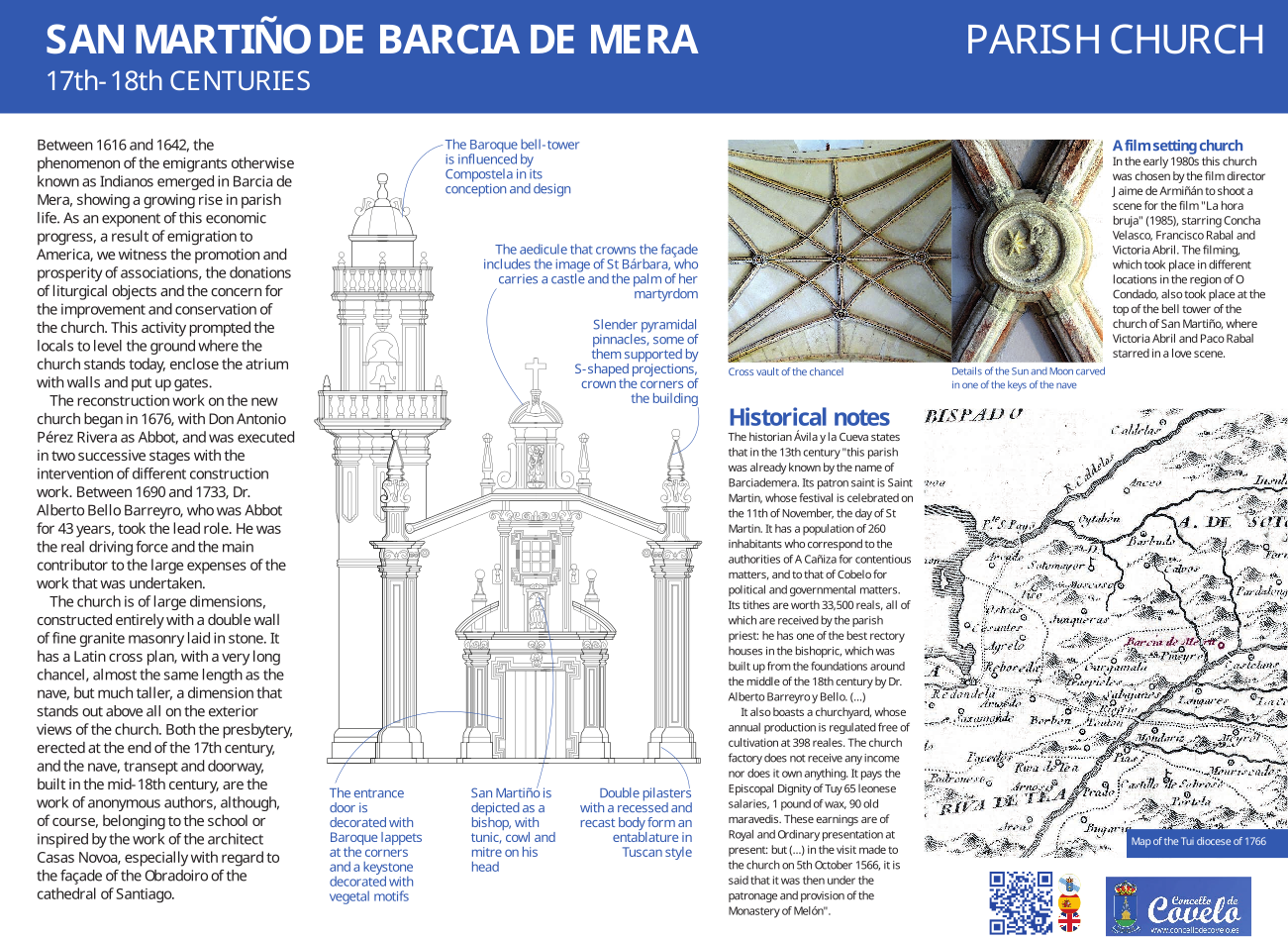
Parish Church (pdf)
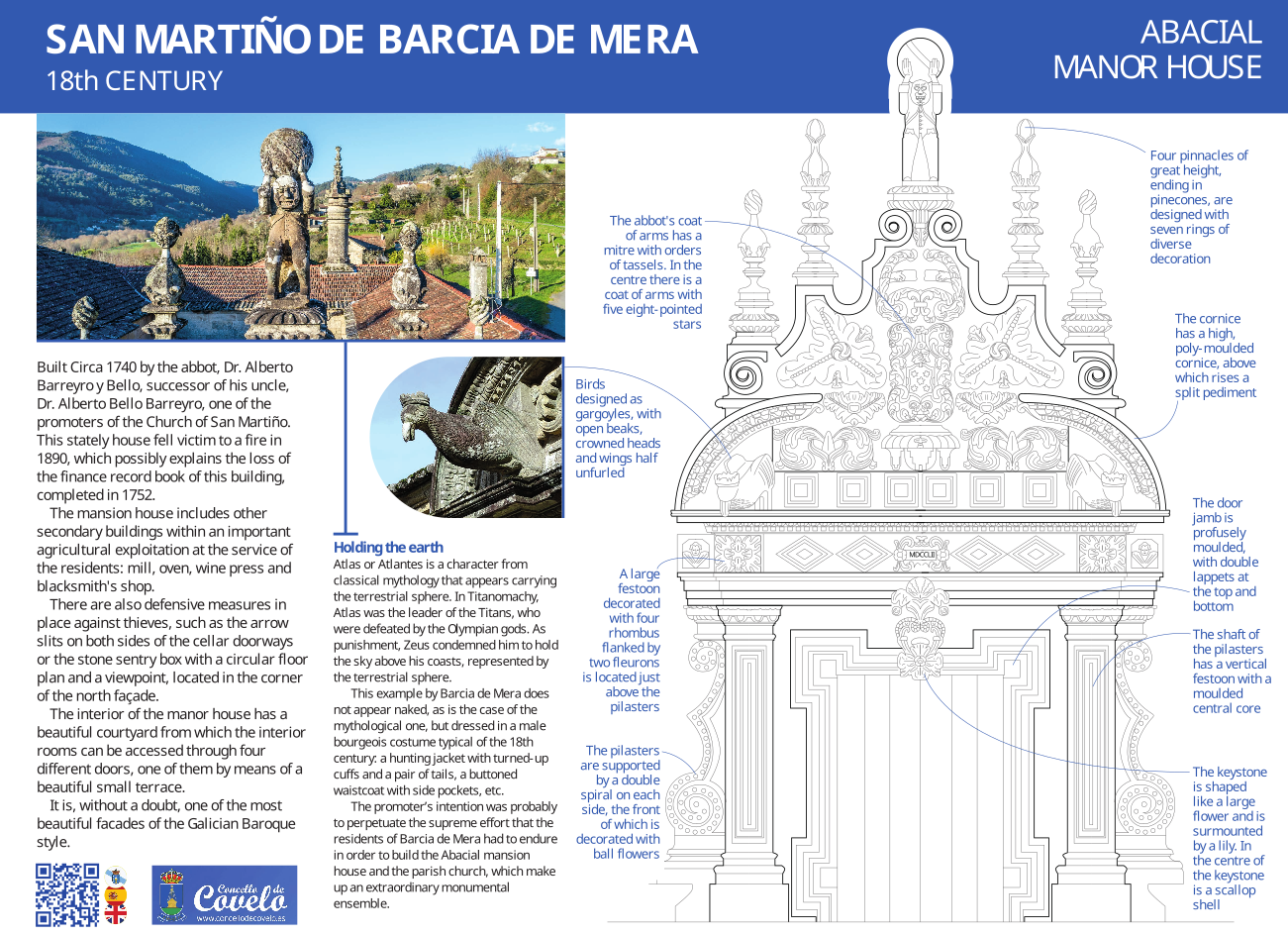
Manor House (pdf)
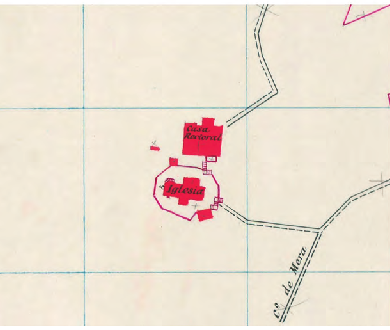
In the Manor House of the parish, converted into a prison for the occasion, and in the paths of San Juan del Mosteiro, some scenes of the feature film "Passion of Mary" were shot. Soliña", the canguesa falsely accused of witchcraft in 1621. The film, directed by Alfonso Castaño in 2012, has actress Luma Gómez in the lead role.
BIC The Territorial Commission of Historic-Artistic Heritage of Pontevedra agreed on 10.07.1990 to transfer to the General Directorate the file for the initiation of the file for the declaration of BIC.
Unfortunately this initiative, like so many others, fell on deaf ears,
like so many others, fell on deaf ears and the file was never fully processed, hence today,
incomprehensibly, the group formed by the church of San Martiño and the Manor House are still not recognized by the Xunta de Galicia as Assets of Cultural Interest.
of the monu-
mental complex of San Martiño de Barcia de Neblina:
"Integrated by the parish church, of grandiose proportions, and the Manor-House singu - Manor-House, it constitutes, besides being unique in Galicia, the most relevant sample of the rural most relevant example of the Galician rural architectural heritage, raised during the 17th and 18th the XVII and XVIII centuries, thanks to the faith and pharaonic dreams of a people, short in population and resources, but selfless in sacrifices."
Perfectly adapted to the environment of the place and the delightful landscape that frames it,
it is located on a hillside, facing noon, in the municipality of Covelo (Pontevedra), depending ecclesiastically of the Bishopric of Tui-Vigo.
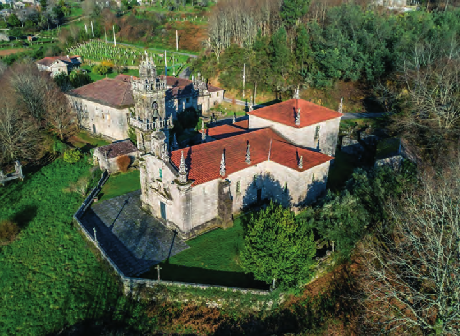 Aereal view of the church of San Martiño
Aereal view of the church of San Martiño HISTORICAL TRAJECTORY
The varied documentation consulted, belonging to the XIV century, confirms that the Bernardo monks of monks of Santa María de Melón, while exercising the Patronage and Provision, "were at the same time feudal lords of the parish and Couto de San Martiño de Barcia de Neblina and, therefore, the of Neblina and, therefore, owners of the Civil and Criminal Jurisdiction, a mere and mixed empire that they carried out through the by means of a Judge or Merino of their own appointment".
A combination of important physical factors such as the abundance of water, fertile soils, rich pastures fertile soils, rich pastures and forests, plus other socio-economic factors, such as the or - ganization of the seigniorial regime and the the orignization of the manorial regime and hereditary transmissions, favored the rapid development of the habitat.
Already in the thirteenth century, the "villa" saw the construction, next to the old hermitage "do the old hermitage "do Mosteiro", under the invocation of Our Lady of the Assumption, a "çeleyro" (warehouse) was built. çeleyro" (large storehouse), so that the steward of the Cistercians of Melon could collect the "Quechelí" after the "Quiñón" and other tributes owed to the monks, by virtue of rents, levies and forums.
of rents, exactions and forums. We highlight as curious details, the gratuitousness of the transport at the transportation at the expense of the payers and the condition that while the said steward and his companions remained in Barcia de Neblina, having direct control and administration of the possessions in that place. of the possessions in that geographic area, it was the duty of the neighbors to give them "communal food and drink". and drink communally".
From the minutes of the Pastoral Visits of July 11, 1528, September 29, 1557 and October 5, 1566, we can intuit that it was the duty of the neighbors to give them "to eat and drink communally".
October 5, 1566, we can intuit the pitiful state that the old building of the parish church was in - humble, dark and small - with a roof covered with thatch due to the lack of tiles.
lack of roof tiles "the ridge let the light and the rain shine through", "the triumphal arch showed dangerous cracks", "in the nave it was urgent to place new beams", "the walls had to be taped and the interior walls had to be whitewashed",
"benches had to be placed so that the nests could sit on them when they went to the church", "it was necessary to put benches so that the nests could sit on them when they went to the church". the nests could sit down when they went to the Offices", etc.
By deed of May 4, 1568, the monks of Melón sold the property to the Count of Salvaterra, Don García de Salvaterra, in favor of the Count of Salvaterra, Don García Sarmiento,part of the manor and vassals of Barcia de Neblina, the reason of seven thousand maravedis each one with the loitosas and other titles of vassalage, among them, the right to emigrate, upon payment of a census (gabella emigrationis), with the sellers annually the sellers annually a certain amount in cash, "two hundred and forty-six ferrados and one and a quarter of rye, three hundred and sixty-one of corn, thirty-one chickens and two quarts of rye. and two quarts of butter", benefits that the foreros would have to pay to the Merino, every 11 and November. Merino, every 11th and November, feast of San Martiño, patron saint of Barcia de Neblina.
They also maintained in the Coto the Civil and Criminal Jurisdiction necessary for the guard and preservation of their goods, as well as to make appraisals with forums for renovation and spoils. This act was to be of great importance for the future economic development of the region, because when, at the end of the 16th century (1564-1599), the bad catches, famine and plague devastated the region, the said Conto plague devastated the region, the said Count, who had served Philip II very effectively in the conquest of Portugal (1580), was the conquest of Portugal (1580), not only favored the strong migratory movement to Lisbon and then to Brazil, but also, thanks to Brazil, but, thanks to his personal influence, he also facilitated the incorporation of his honored the incorporation to the guilds established in the new residences, acquiring, immediately, the condition of citizens,
From 1616 the Indian phenomenon arises in Barcia de Neblina, evidencing a growing boom in parish life. And as an exponent of that economic progress, swim from the triumphant emigration, we see recorded in the parish books, the promotion and prosperi - Donation of the Confraternities, donations of ornaments and liturgical objects, concern for improvement and conservation of the church, which is also extended to the hermitages of San Roque, Santo Tomé and the archaic Nuestra Señora del Mosteiro.
Such activity moves the neighbors to flatten the plateau where today the temple sits, close with walls the adro and put gates on it. These works were finished in 1642. In the visit that takes effect (1672) the Prelate tudense, Don Bernardino León de la Rocha, ordered the Abbot, "among other good things", the updating of the funds, that the Books of Accounts and Petitions be the Books of Accounts and Petitories, that "he should give the virile one and the taking and reason of him that dies ab-intestato" to invest the "fifth" of his inheritance in the works of the Church, but as this "in the one has Factory it is this "in the has Factory is distributed among the parishioners the expenses, according to him of each one".
Three years later (1675), the bishop Fray Simón García Pedrejón, arranges the widening of the body of the Church, by the of the body of the Church, by the part of the Epistle at the expense of the neighbors, "for in the fit these the Mass". It is in charge of making the distributions and to perceive his amount, the general procurator of the parish, Sebastián Fernández, who due to the delay in the delivery of funds, it is necessary that the bishop himself require it. the bishop himself in 1677. Parallel to the economic reorganization, a rational study of the difficult problems that the rational study of the difficult problems that the projected enlargement works planed, both in the formal aspects and in the both in formal and structural aspects. In view of the unfeasibility and lack of coherence of the work, it was decided to build a new, larger, more beautiful and moving church. more spacious, beautiful and moving forms, in accordance with the stylistic airs of Santiago`s baroque style.
The lack of a Libro de Fábrica (Factory Book) prevents them from knowing fundamental data for the history of the history of Barcia de Neblina. Since time immemorial (as recorded in 1625), the church`s the Church it is customary that the parishioners share them among themselves, "the rich as rich and the poor as poor".
To this we must add the absence of contracts, plans or receipts.
Only the Books of Confraternities allow us to obtain important data, since those of Visits or Mandates, due to their extracted wording, do not allow us to obtain important data. or Mandates, due to their extracted wording, with respect to the execution of the works, are null and void for our knowledge. the execution of the works, they are null for the knowledge of their costs or identification of the name of the artisans that in them they left the traces of their artistic genius.
From the analysis and evaluation of the architectural elements and the scant documentary support, we can clearly deduce that the works We can clearly deduce that the reconstruction works of the new parish church, began in the year 1676, with Don Antonio Pérez Rivera as Abbot, and was carried out in two successive stages, in two successive stages, perfectly individualized and with the intervention of different workshops, judging by the the inter- vention of different workshops, judging by the quality of the shavings and style. The initial stage, started The initial stage, started by the aforementioned Abbot until his death and continued from 1690 to 1733 by Dr. Alberto Bello Barrey. Alberto Bello Barreyro, who served as Abbot for 43 and a half years.
He was the real driving force and main contributor to the great expenses of the works. He was born in the place of Espiñeiro in the parish of Barcia de Neblina. He was a rich man, to the point that he came to hold a Commissariat of the Holy Office of the Inquisition of the
Kingdom of Galicia.We have evidence that a certain Pedro Tomedo, 78 years old and a resident of Barcia de Neblina, is listed in a "Relación de Familiares de Neblina".
in a "Relación de Familiares que al presente hay en él Reino de Galicia" linked to the Holy Inquisition dated 1641.
in the year 1641, This list is conformed by a total of 218 names (La .H .N. Sec. Inq. Leg. 2900). Therefore,
Therefore, it is necessary to deduce that Alberto Bello was not the first representative of the Holy Inquisition in our parish, although he could have been the first one.
parish, although he could have been the first commissary of the Holy
He died on July 14, 1733, having passed away the previous June 26, before the notary public,
Don Juan Estévez Gettino -Jurisdiction of the Astillas-, declaring to have constituted
foundation of bond, morgado and pious work, before Don Francisco de Castro, notary public of the
Jurisdiction of Salvaterra.
In the course of that first phase, the church was erected almost in its entirety, and the beautiful vaults were exceptions.
The construction of the beautiful vaults with rich keystones and covered terceletes, sacristy, concluded in 1740, during the
The church was completed in 1740, during the second stage, by the nephew of the previous Abbot, also called Alberto, but with the surnames Barreyro and Bello, who left the coat of arms engraved on the keystones of the engraved coat of arms on the circular keystones located in the centers of the vaults that finish off the body of the transept and the sacristy.
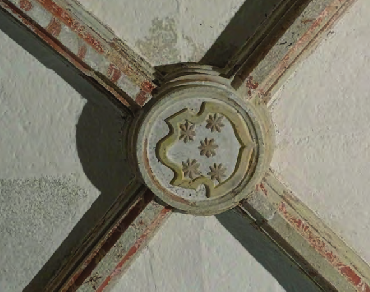 Weapons of Alberto Barreyro inscrypted in the key of the sacristy.
Weapons of Alberto Barreyro inscrypted in the key of the sacristy.Nothing is known about the master architect, author of the monumental complex of Barcia de Neblina. Undoubtedly he is a native of Compostela, but we do not dare to venture a guess, a name, because at that time there were several of proven quality that shone with their own light in the city of Santiago de Compostela. own light in the city of Santiago, following the dictates of Domingos de Andrade. What is that is clearly demonstrated is that in these works the monks of Melon do not have any participation the monks of Melón, as has been repeatedly maintained.
Altarpieces
When the construction of the parish church of Barcia de Neblina had not yet been completed, the brotherhoods of the Blessings of the Blessed Virgin of Melón were not involved in the work, the brotherhoods of the Blessed Souls of Purgatory and of Our Lady of the Rosary, the abbot, Dr. D. Alberto Barreyro Bello, decided on July 5, 1739, to hire the Master of Architecture and Sculpture contract with the Master of Architecture and Sculpture Francisco Alonso de Castro, a neighbor of Porriño, to build two Porriño, for the construction of two altarpieces "for the price of three thousand six hundred and six reales of fleece. And for the misery of the times and calamitous years in the power of the confraternities of said Brotherhoods to afford such an amount, they agreed that it be taken from all three confraternities -Sacramento, Animas and Nuestra Señora - all that can be taken from all the three confraternities, being left what is necessary for the common needs and expenses; and that what is lacking be taken from the the fiado is taken out until there are effects to be able to pay all that is thus taken out".
The aforementioned Brotherhood of Souls, constituted in 1673, had since 1676, on a provisional basis, in the "Capilla de Animas" (Chapel of the Souls). in the "New Chapel", a dais and on it, a painted table allusive to the Purgatory, to promote the devotion to Purgatory, to promote the devotion of the faithful.
It was the master Alonso de Castro, firm value within the Galician retabilistic panorama, where he left abundant works. he left abundant works. Three years earlier he had completed the famous "Altar de las Reliquias Relics" in the Cathedral of Tui. The Altarpiece of Souls occupies the whole of the testeira wall of the penitentiary wall of the of the penitentiary wall of the North arm of the cross. Of fully baroque style, it is made of chestnut in chestnut wood and in it Alonso de Castro shows his maturity and high artistic quality, both for his prolific artistic quality, both for its prolific and refined decorative work, the base of rockeries or strings of fleshy of fleshy leaves and flowers, as well as in the composition, always seeking the line of movement in plan and elevation. This altar is elevated on a rich base and a table meticulously decorated with carving and painting work. It consists of a predella, a single body and an ample attic divided by three separated streets by means of exempt and ascending stipes enriched by varied and ascending stipes enriched by varied vegetal decoration.
The Confraternity of Our Lady of the Rosary, whose existence is recorded in the year 1621, although the Constitutions were approved fifty years ago. the Constitutions were approved fifty years later, raised the altarpiece in honor of its patroness in front of that of Ánimas, in the chapel that was once the south arm of the transept, with the inter- vention of the same altarpieces. the same retablists described above, who maintain identical styles and structures, as well as the same and structures, as well as similar very fluid clear-oscurist decoration.
As in the previous case, the design is integrated by a chestnut wood base, to which is attached the table, bench, single body and curved attic, which closes against the vault, the whole altarpiece.
The center of the bench is occupied by the tabernacle with a door carved in low relief. door carved in low relief. Above it starts the central body presided by the carving of the Venir-. rich of forms and balanced movements, that carries between its arms the Child in attitude of blessing. attitude of blessing. This beautiful processional image is sheltered in the fornela of arched round arch, flanked by a flanked by supports with straight feet and delightfully carved stipes. deliciously carved. The dilated attic is centered by a quadrangular window with considerable and is decorated with small and exuberant vegetal ornamentation. The two lateral symmetrical side streets, in which there are semicircular fornels, seated on well carved pedestals with well carved pedestals with graceful heads of angels that serve as support to the images of Saint of Santa Ana and Sano Xosé, parents of the Virgin.
The sculpture of both altarpieces is excellent, showing the maturity of Master Alonso de Castro in the finish and composition of the work. in the finish and composition of the work, outstanding qualities, expressive faces and hands, gentle and hands, soft prayers and fertility of resources. The value of the altarpieces is enhanced by the high quality of the gilding and polychroming that took place in 1753. carried out during the year 1753, perhaps by Portuguese artists, habitual collaborators of the Master, whose hands whose hands we notice in the bottoms of the fornelas and frontals of the tables disteis altarpieces, for their very colorful paintings, of varied floral themes.
Following a chronological order, we will say that attached to the North and South walls of the main arm of the cross, the altarpieces were erected on the north and south walls of the cross. the north and south walls of the main cross are the altars dedicated to the Sacred Heart of Jesus and Our Lady of Carme, respectively. Señora del Carme, respectively, works executed by the even anonymous author in chestnut wood, face in chestnut wood, face 1780. Completely "rococo", they are articulated in a simple way: base, bench, a body simple: base, bench, a body and on the cornice overhang, the attic. The two divided divided into three sections by free-standing stipes, moved and not very ornamented. Its decoration is the base of rockeries, vegetal themes and marble veining, very much to the taste of the time. The artistic The artistic quality is mediocre and its ancient imagery was largely replaced by more modern by a more modern one of industrial production.
Collateral to the triumphal arch are located to the right and left, the small altarpieces of Santa Lucia and San Lucia, and to the right and left, the small altarpieces of Santa Lucia and San Lucia. of Santa Lucia and San Bieito, respectively; possible fruits of donations, since we do not know their author. we do not know their author. They belong to the "rococo-neoclassical" current and must have been the first quarter of the 19th century. The images of the titular saints, which, because of their personal - The images of the titular saints, which are so personal attributes, are sheltered in fornelas of trilobular arches, flanked of high columns of Corinthian style, slightly advanced, on which the architrave rests, that precedes architrave, which precedes in height to the crowning, of trimmed and undulating lines that give great verticality to the verticality to the ensembles. In the central boxes of the attics, the carvings in rounded round carvings of Sano Mauro, Abbot and Sano Franco de Siena.
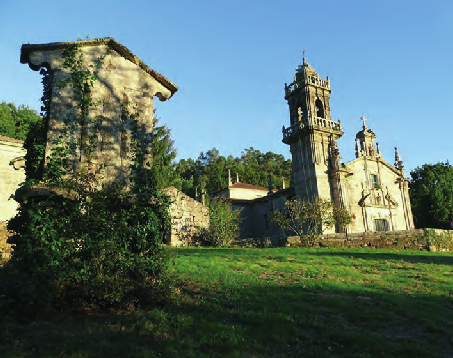 Canister of Manor House and San Martiño`s church
Canister of Manor House and San Martiño`s church The sobriety and purity of lines, contrasts with the golden polychromies and the greenish and red marbleized red and greenish marble, postulated by the Academy. Finally, it is worth mentioning the main altar, which presides over and decorates the chancel of the presbytery. According to an inscription painted on the central rib of the chapel`s vault, it reads: "Si hizo y pintó por él Abad painted for him Abbot, Dr. Ceferino Antonio Iglesias y Lago. Lamb 1816".
The said abbot,born in the town of Redondela, was parish priest of Barcia de Neblina for forty-five years.
It is not strange that for the realization of this work he had claimed the intervention of a countryman artist of that of a fellow countryman artist of that town, who left in the south of Galicia and, in particular, in the capital of the diocese of Redondela, and, in particular, in the capital of the diocese of Tudense, magnificent examples of artistic ability.
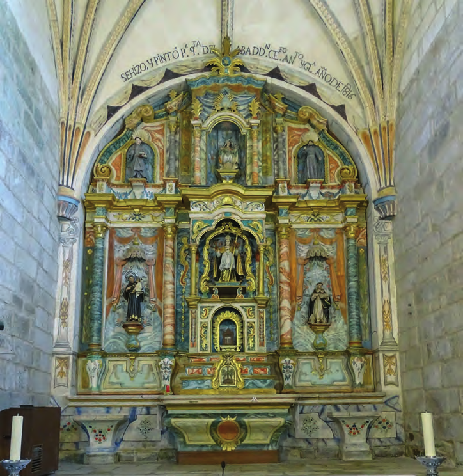 Retablo of the high altar
Retablo of the high altarIts neoclassical façade is admirable for its monumentality and aesthetic quality, It cannot escape the previous baroque influences, intentionally underlined by the gilding of the fine ornamental motifs the gilding of the fine ornamental motifs: borders, garlands, corbels, scrolls and stylized plant decoration, to which it vegetal decoration, which serves as a counterpoint to fine polychromy imitating jasper and marble in a variety of colors and veining.
It is a pity that the charm and unity that would provide the contemplation of its original sculptures had been lost, since the exception of two, San Martiño and Sta. the rest are scattered throughout the church.
The layout of the altarpiece, in ascending sense, is integrated by pedestal, bank, main body and curved attic, which is main body and curved attic, which closes the whole. Vertically it is divided into three streets -the longest one in the center-, separated by four tall columns of composite order. These support elements sustain the pronounced entablature, topped with colorful colored nix, which is straight and nixa, which is straight in the lateral streets and mixed in the center one. The attic rests on top of it, also of three streets and three fornelas, adorned by mixtilinear moldings and near by an end fleuron. by an end fleuron.
In the lateral streets of the single body are symmetrically placed, in boxes, under collected doseis, the images of the Purity of God. collected, the images of the Purísima and Sano Xosé, the right and left, on high men - sulons. The central street is structured, from top to bottom, by tabernacle -embedded in three small tiers-expository and The central street is structured, from top to bottom, by a tabernacle -embedded in three small tiers- and a niche in the axis of the altar to house the statue of the titular San Martiño, bishop of Tours, dressed in pontifical dress, with his right hand blessing.
DESCRIPTION OF THE CHURCH
Interior
The church is of large dimensions, made entirely with a double wall of fine granite dog-eared stone. It would have of fine granite placed to bone. It has a Latin cross plan, with a very long presbytery, almost of the same length as the nave, of the same length as it, but of much greater height, dimension that stands out above all in dimension that stands out especially in the exterior perspectives of the temple. Both the presbytery, begun at the end of the 17th century, as well as the nave, transept and doorway built in the middle of the 18th century, are the work of the XVIII century, are the work of anonymous authors, although, of course, of the school or inspired by the work of the or inspired by the work of the architect Casas Novoa, especially the one referring to the façade of the cathedral`s Obradoiro de la Catedral. Obradoiro of the cathedral of Santiago de Compostela. The church has two added bodies: the sacristy, attached to the north wall of the presbytery, and the small nave of the baptistery, on the first floor of the tower, attached to the north wall of the first section. first bay.
The main nave is divided into three bays of different lengths, separated by semicircular arches. faixóns of semicircular directrix, all of them decorated in its intradorso by a festooned recast. neado recast.
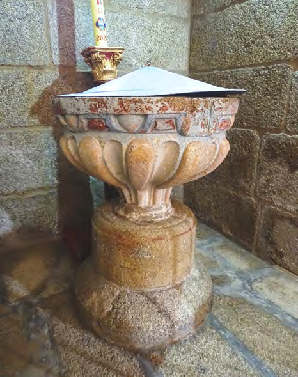 Detail of the bauptisms pía of the baptistery.
Detail of the bauptisms pía of the baptistery.The rectangular sections formed by these faixon arches are covered by a system of cross and star vaults, more typical of the Renaissance style. of a system of cross and starred vaults, more typical of the Galician Renaissance style of the 16th century than of the Baroque Galician Renaissance style of the XVI century than the baroque style of Compostela that the rest of the building has. The first section has two superpost vaults, the one of the roof and the one of the tribune, both cross vaults, with the ribs of gothic profile.
The vault of the roof has a large circular keystone topped in its center by a very curious pinxante of a very curious pinxante of vegetal decoration that hangs more than sixty centimeters. The mullioned ceiling has large perpendiculars. The tribune vault is similar to the one located above it, although of flatter directrix, supported by a carpanel arch that rests on the pilasters that serve as support, in turn, to the first
The original says, by mistake, "bell arch".
,
the first faixon arch. This arch and the pilasters have as exterior pilastersThe original says, in error, "campanel arch." The two buttresses are well embedded in the wall, although of later construction than the rest of the vaults and walls. vaults and walls.
Las pilastras de todo el templo están decoradas con festoneado vertical refundido, rema - tadas en su parte superior por capiteles moldeados por dos listeles entre los que se sitúa un cuarto de bocel; las basas de planta rectangular se rematan en un grueso toro. En este primero tramo los capiteles fueron suprimidos, ya que coinciden en altura con el arco formeiro carpanel de la tribuna, sobre lo que se apoya el arco directamente.
The pilasters of the whole temple are decorated with recast vertical scallops, topped at the top by capitals molded by two the bases of rectangular plant are finished off with a thick torus. In this first section the capitals were suppressed, since they coincide in height with the arch formeiro carpanel of the tribune, on which the arch rests directly. The ribs of these two superimposed vaults rest on corbels recessed in the angles. in the angles. The keystone of the tribune vault, also circular and decorated in bas-relief with a crescent moon and a star with a crescent moon and a star, a direct allusion to the entrance of the church into the Mystery of the Re- dence (night-day, sin-salvation).
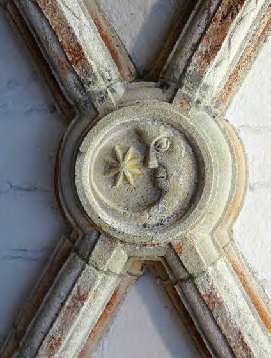 Detail of the sun and moon of the nave.
Detail of the sun and moon of the nave.The second bay is covered by a vault of terceletes, with five keystones and pleated perpendiculars of of perpendiculars of great length, the ribs resting on four corbels recessed in the angles of the corners. the angles of encounter of the exterior walls with the pilasters of support of the arches faixóns. faixón arches. The keystones are carved in bas-relief and polychrome and decorated with five characters. The central keystone, circular and of larger dimensions than the rest, is decorated with the figure of San Martiño, with bicolumns. of Saint Martiño, with crosier and mitre, titular of the church; the other four keystones, also circular, represent the four represent the four Holy Fathers of the Church: St. Xerome, St. Ambrose, St. Gregory and St. Augustine.
In this second section of the church there are two doors, one in each of the north and south walls. and south walls, linteled on the exterior faces and topped with lowered arches on the interior faces. interior faces. On the exterior, these doors are decorated with a shawl topped with earflaps on the upper on the upper corners and on the interior they are smooth.
Two pairs of rectangular windows, placed vertically and symmetrically, also open on the two north and south walls, with internal spillage, on all four sides. In the first section and at the level of the tribune, there is a small window on the south wall with similar characteristics to those described for the windows of the characteristics similar to those described for those of the second bay.
The third bay of the nave is the central body of the transept, made up of three bays. three bays. The central body is covered with a vault of terceletes similar to that of the second bay of the nave. the second bay of the nave, but in this case with nine keystones, since the central cross ribs are slightly prolonged. The central cross ribs are slightly prolonged until they end in keystones. All the keystones decorated in bas-relief with vegetal motifs, except for the central one, which is larger and decorated with an interesting theme. decorated with an interesting theme: an abbot`s coat of arms, since it has a hood with tasseled orders. and in the center a coat of arms with five eight-pointed stars. central star, of greater dimensions than the other four that surround it. This coat of arms is repeated in other places of this monumental complex: in the keystone of the vault of the sacristy and in the doorway of the abbey manor.
The ribs, as in the rest of the church, rest on corbels recessed in the angles of the corners.
This section that we are describing, and which is said to form the transept, is extended to the north and south in two chapels to which two chapels are south in two chapels that are accessed by two semicircular arches, decorated by a core in the of its intradorso by a recast central nucleus, supported by pilasters with identical decoration and covered both chapels by barrel vault of semicircular directrix, which are supported by continuous imposts molded in heel profile. Symmetrically symmetrically, two rectangular windows are located in the western walls of these chapels, with internal and another window of similar construction in the penitentiary wall of the chapel on the south side. of the south side chapel. In the transept walls there are two baroque altarpieces, of good workmanship with interesting and with interesting images of the XVIII century.
The presbytery is of large dimensions, rectangular in plan, covered by a 5 keystones vault and two large windows of internal spillage in the north and south walls; the masonry, as in the rest of the vaults, is of long perpendiculars, Gothic profile ribs resting on corbels recessed in the four corners, and keystones -in this case- ellipsoid, with vegetal and geometric motifs in bas-relief.
In the north wall of the presbytery there is a door with a molded shawl decorated with upper lugs, access with upper lugs, of access to the sacristy, which is in turn of rectangular plan, covered with a cross vault whose circular keystone is decorated with the abbot`s coat of arms described above. of the five stars.
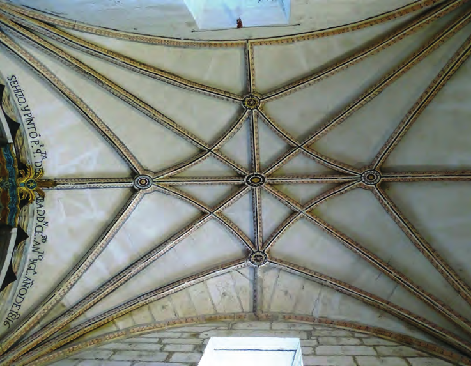 Detail of the nerved vault that covers the prebystery
Detail of the nerved vault that covers the prebysteryThe great main altarpiece, from the 19th century, with beautiful carvings, occupies the whole of the testeiro. The interior of the church stands out for its expressive force and the ingenuity of its execution. the paintings that decorate the totality of the ribs, the pilasters and the intrados of all the arches. the arches, decorated with marbling, marbling and plant motifs in shades of gray, yellowish paintings carried out in their totality in the year 1804, according to the parochial books.
As furniture, without counting the altarpieces that we will describe separately, it emphasizes in first first of all, the beautiful baptismal font, located in a small chapel attached to the north wall of the first section of the nave of the first section of the nave, which is none other than the first floor of the tower, to which we will describe separately.
The access is through a smooth semicircular arch, the nave is covered by a barrel vault. vault. The font is of very beautiful workmanship, of the XVIII century, polychrome, decorated with two orders of ovals, some recast and others not, topped by a cornice decorated with decorated with geometric motifs, zigzag ring with ovals.
The pulpit is also remarkable, with a cup decorated with ovals, a half-height ring with vegetal decorations, with a square base and a square base. vegetal decoration, with a quadrangular base. The balustrade is made of turned and polychromed wood and the and the octagonal shaped wooden and also polychromed turnstile.
Exterior
In the exterior the western facade stands out with its great cover. The door, rectangular, of lintel adobe with its keystone decorated with vegetal motifs and molded shawl and decorated with double lugs, upper and lower. On both sides of the door and in order to support the architrave and the split pediment above it, were built above, two large double pilasters were built, decorated with vertical festoons and decorated with vertical decorated with vertical festoon and carved nucleus at two levels, seated on high bases with rectangular of rectangular elevation topped by Tuscan bases, whose torus is imposed on both sides of the doorway to form the base of the corner pilasters of this western façade and which continues to extend to the west. the base of the corner pilasters of this western façade and which continues to extend to form the base of the great tower, attached to the north wall of the church.
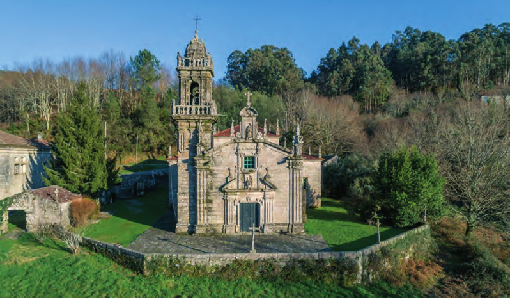 West facade of the temple.
West facade of the temple.The molded capitals that top the two pilasters of the façade, support a four-banded, superimposed listeis, which in turn support a large frieze mixed with a listel, gola and with listello, gola and pingadeira, support of the split pediment, with the same moldings and semicircular and of semicircular depressed directrix, that receives in its center a fornella with the image of San Martiño, flanked by the of San Martiño, flanked by two pilasters. From the tympanums of the pediment rises a pinnacle per side, topped by balls.
Above the fornella of San Martiño, patron saint of the church, there is a large window with highly molded xambas decorated with earflaps, which serves to give light to the choir. Two tall pilasters flank the window. flank the window, to receive the wide overhanging cornice at the end, the gable and with a central horizontal and with a horizontal central section, on which rests another large fornella with the image of Santa Barbara, with the of Saint Barbara, with the castle and the palm of martyrdom in her hands. The fornella is finished off with another semicircular split pediment, the center of which houses the terminal cross of the cross of the façade. On both sides of the pediment there are two supporting finials and two pinnacles finished in ananas.
The western façade is topped at both ends by large, double, angular pilasters, of recast decoration and topped by high pinnacles in the form of pineapples. Everything in the workmanship of this beautiful façade, decorations, fornels and pinnacles, reminds them of the cathedral of Santiago de Compostela, especially in its western façade.
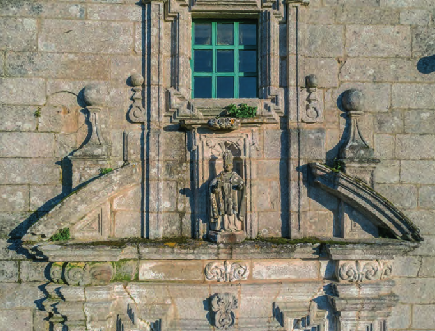 Detail of the facade of San Martiño.
Detail of the facade of San Martiño.The large tower and the slender pinnacles topped with boulders, located in all the corners of the roof and in the center of the panels, also stand out on the outside. The side doors, located in all the corners of the roof and in the center of the panels. The lateral doors The lateral doors are decorated with earflaps and the rectangular windows are plain. The large baroque cornice baroque cornice has a great molding of pingadeira.
The bell tower, of Compostela influence in terms of conception and design, is located to the north of the western façade. north of the western façade, with a quadrangular plan, built like the rest of the church with perpiaños The church has a quadrangular floor plan, built like the rest of the church with well carved perpiaños placed on bone, and structured in three bodies: cane or drum, belfry and balcony capital, bell tower and balconied capital.
The cane is divided into three sections separated by two imposed girths; from the top to the bottom, it is the highest is adorned with hanging plates cut in semicircle and located in the angles. in the angles.
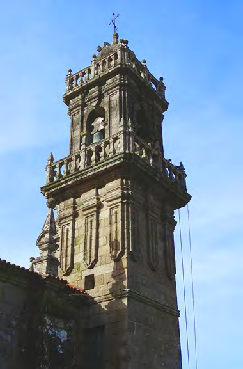 Detail of the bell tower.
Detail of the bell tower.
The body of the tower or campanile rises on a great baroque cornice, also of quadrangular plant, decorated with decorated with a hole on each side, topped by semicircular arches and smooth, peralted arches, which serve as a sounding board for the bells that are located inside.
These openings are flanked by pilasters with short bases, recessed recessed shafts and and Tuscan entablature. This body is surrounded, like the towers of the of the cathedral of Santiago de Compostela, by a perimetral balcony made up of balusters of complex profile, pilasters in the angles of recast core, molded railing and three terminal pinnacles per side.
The last body of the hemispherical spire is ornamented by four projections in that (S) and a central pinnacle crowned by a ball supporting the vane. central pinnacle crowned by a ball that supports the weathervane and the end cross.
Similar perimeter balcony to the one we described completes this high body of the tower.
MANOR HOUSE
This beautiful manor that settles its ancient roots on the side of the parish church of Barcia of Neblina, conformed unit with it, conserves the typology and the aesthetic scheme of the typical of the typical stately mansion located in a rural environment during the baroque period. Hence the obvious stylistic links with that art, whose main focus in Galicia, was Compostela.
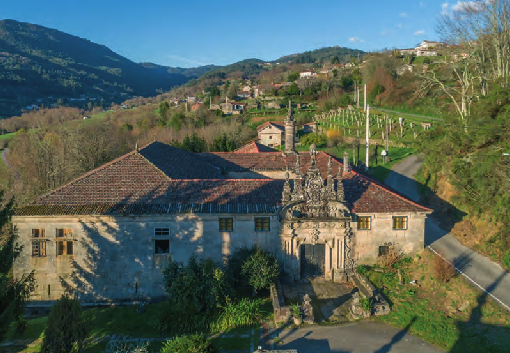 Aerial view of the manor house.
Aerial view of the manor house.It is wrongly attributed several founders and multiple destinations, such as, for example, monastery, convent, pilgrims` hostel, etc. But its construction had only one was to be the Manor House; but at the same time, it would also have other secondary dependencies secondary dependencies within an important agricultural exploitation at the service of the neighborhood, such as mill, oven, winepress as mill, oven, wine press and forge. Even defensive resources against thieves were foreseen in its planning, as testified by planning, as evidenced by the troneiras existing on both sides of the cellar doorways or in the stone sentry box with a circular floor plan and a sight, located in the corner of the north façade. corner of the north façade. An anecdotal risk was the constant concern of the abbots for thieves, which would have of the abbots about thieves, which was to be confirmed in 1838.
The manor was ordered to be built in 1740, after the work on the sacristy had been completed, the abbot, Dr. Alberto Barreyro y Bello, successor of his uncle, Dr. Alberto Bello Barreyro. Barreyro. The famous historian Avila y la Cueva confirms this assertion when he of Barcia de Neblina in his "Historia Civil y Eclesiástica de la Ciudad de Tuy y su Obispado" (Civil and Ecclesiastical History of the City of Tuy and its Bishopric), says Bishopric", he says: "It has a rectory house of better wools of him Bishopric whose made from the foundations since the the foundations since the middle of the XVIII century the doctor Don Alberto Barreyro y Bello, Abbot of the same one...".
This illustrious benefactor "was twenty-seven lambs to the front of the parish that saw him to be born, until his death, which occurred suddenly on October 15, 1761, he worked tirelessly for the benefit of Barcia de Neuquén. tireless work in favor of Barcia de Neblina. He died without testamentary, having left in his own handwriting a for a thousand masses, which will be distributed among the Parish and the usual Convents".
There is no information about the artists who created it or the cost of this masterpiece, since there was never a Libro de Fábrica. as there was never a Libro de Fábrica (Factory Book). The expenses were distributed among the whole neighborhood. Did the fire suffered in 1890 affect the documentation of the Pacega? The ostentatious mansion impresses by the contrast between the severity of the solid granite exterior walls and the the decorative sumptuousness of the main façade, which, like a triumphal arch, serves as the entrance to the triumphal arch serves as access to the manor.
Centered on the linteled architrave of this doorway is a cartouche inscribed with the year of the end of the work, the year of the construction. the year of the end of the work, 1752. And above, on a cantilevered ledge, ornamented with profuse and stylized fronds, the coat of arms stone of the "Bellos" of Barcia de Neblina, without abbot`s tassels of abbot.
The façade is crowned with the statue of Atlas in rounded bulk, flanked by two pinnacles by two pinnacles of ball on each side, topped by ananas. Undoubtedly it was intended to perpetuate the supreme the supreme effort that the united town of Barcia de Neblina had to endure to obtain such an extraordinary historical-artistic ensemble.
Exterior
It is a beautiful paciego building from the middle of the XVIII century (the year 1752 appears on the cover). rectangular floor plan with an interior patio, and a quadrangular body added later on the north on its north side, dedicated to a mill and oven, which gives the building an L-shaped floor plan. L-shaped floor plan.
he whole building is built with excellent fine-grained perpiaños placed without mortar. mortar. The walls of great thickness are built on a double slab on the west façade. on the west façade. Large cornice and windows divided by trabatel, typical elements of the Galician baroque style. of the Galician baroque style. The cornice is molded in two superimposed bodies, the superior one composed of listel-gola-listel, thick separating pingadela, and the lower body molded in listel-half-cane-listel, thick separating pingadela, and the lower body molded in in listel-half reed-listel.
A thick toric imposition runs along the upper part of the walls, under the cornice, surrounding some of the windows on the south side as an alfiz; in the rest, it serves as a rain screen. On the north façade there is a graceful balcony, since due to its location it cannot be called a solana. supported on the ground floor by four columns with quadrangular bases and pseudodóricos capitals and others of polygonal section in the high floor, supported on high quadrangular bases decorated with plaques. The balustrades have disappeared, but balusters have disappeared, but the handrail, which is molded, is preserved.
The body of the mill attached to the manor, which is located on this north side, consists of three the ground floor, dedicated only to house under a stone vault the blades and machinery of the mill. and machinery of the mill; the second floor, dedicated to the mill itself, in a room connected to the the large kitchen (where, in addition to the millstones, there are two millstones and the entrance to a cylindrical and the entrance to a cylindrical body of guard); and the upper floor, possible bedroom of the servants, with its wooden floor structure, today demolished.
This cylindrical body located in the angle where the central body meets the mill body; possibly served as a latrine for a time and is topped by a spire and a pinnacle and pinnacle with ball, having an arched sight with internal spill. The eastern façade is the simplest, without openings, and with the first floor converted into a semi-slope because of the unevenness of the ground.
The western façade has seven windows on the upper floor, with a baroque trabatel, one of which also has a cantilevered rain shower. On the first floor, in the center of the façade, is the entrance door to the wine cellar, which is entrance to the cellar, which is accessed by three stone steps, with an arch on each side. each side.
The south façade is the richest, since it is decorated with the main doorway. It has seven windows, four of them located at a higher level, so that the imposed toric is forced to surround its upper part, serving as tornalluvias. These windows do not have trabatel. The doorway is very richly decorated, with a rectangular door with two leaves, decorated shawl decorated and of adobe lintel, decorated the set with a split pediment, leafily decorated, with a depressed arch trajectory.
El chal de la puerta es muy moldeado, de dobles orejeras superiores e inferiores. La clave decorada con una grande flor tetrapétala, coronada por una bacaladilla estilizado y, en su centro, una concha de vieira. (Posible simbología: la flor representaría la Cruz; la bacaladilla, María; la concha de vieira, la Resurrección del Señor).
The shawl of the door is very molded, with double upper and lower lugs. The keystone decorated with a large tetrapetal flower, crowned by a stylized blue whiting and, in its center, a scallop shell. (Possible symbolism: the flower would represent the Cross; the blue whiting, Mary; the scallop shell, the Resurrection of the Lord). On both sides of this door there are two pilasters with a high base, on which there are bases with an of attic profile (bull-scythe-bull). The shafts of the pilasters have a vertical scalloped with a vertical festoon with a molded central core. These pilasters are decorated as lateral buttresses side buttresses, with a double worm on each side, decorating their front with buttons, as a very ornamental buttons, as a very stylized ornamental resource that confers great ornamental richness to the façade. the lower part of the façade.
Above the capitals decorated with superimposed moldings, listels and quarter roundels decorated with ovals, there is an architrave of four superimposed planes on which is decorated with four losanges also of superimposed planes and two fleurons, located just above the pilasters. located just above the pilasters, there is a large cornice, very overhanging and polymolded, on which rises the split pediment, with a depressed arch guideline. In the center of the four losanges we find a rectangular cartouche, with vegetal decoration, which reads which reads, in Roman numerals, the date MDCCLII.
In the tympana of the pediment there are large figures of an oval on each side, very protruding, gargoyle-like, with their beaks open, their heads crowned, and their handles half unfolded, in an attitude of in an attitude of quantum, (symbol of the Resurrection?), a motif that constitutes a
striking decoration.
The authors did not notice that the crowned bird that appears in the noble coat of arms of the Casa del Souto, possible residence of the parish priest Alberto Bello, uncle of the promoter of the Manor House, could be the basis for the use of this coat of arms.
residence of the parish priest Alberto Bello, uncle of the promoter of the Manor House, could be the basis for the use of this zooform motif on the façade.
zooform motif on the façade.
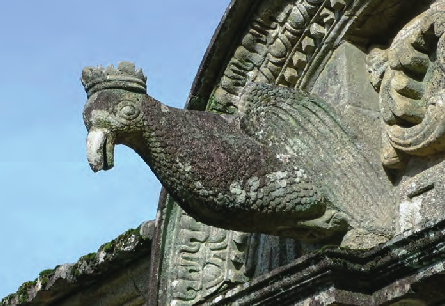 Detail of the crowned birds of the manor.
Detail of the crowned birds of the manor.The center plane of the pediment is decorated with a multitude of motifs, in the lower part six quadrangular figures and the rest vegetal motifs. In the center and at the top of the pediment we see the large abbot`s coat of arms, which we have already described, with the five stars, surrounded by profuse vegetal decoration.
The end is made by means of a mixtilinear cornice, very split, decorated by four pinnacles and a fifth, higher central one. pinnacles and a fifth, higher central one, crowned by an image, apex of this big cover.
This figure represents
Atlas In classical mythology Atlas is the brother of Prometheus, Epimetheus and Menencio and father of the Hesperides. His daughters were the Hyades, Calypso, Maya and the Pleiades. Atlas was the leader of the Titans in the Titanomachy, and when they were defeated by the Olympian gods, he
by the Olympian gods, he was punished by Zeus to hold the sky above their shores. "With his help, Herakles
was able to complete his eleventh labor, as Atlas marched off to the garden of the Hesperides for three given apples, leaving the hero while
The hero was left with the world on his shoulders in the meantime. When Atlas returned with the apples, he intended to take them back to
to Eurystheus, but Herakles asked him that he had replaced him while he put on a cushion to relieve the weight of the orb.
the weight of the orb. On the titan`s acquiescence, Heracles ran away from there." (De la Plaza Escudero, Martínez Murillo y Vaquero
Ibarra. Cuadernos de arte Cátedra. 2016)
condemned by the god Jupiter In Greek mythology, where the myth of Atlas already existed, the god Jupiter receives the name of Zeus.
to support the celestial globe
perpetually on his shoulders, another motif of baroque decoration, very compositional.
telan decorative motif. This figure is made in rounded bulk, very smooth; it seems as if its author was someone else
less experienced than the author or authors of the lower part.
The four lateral pinnacles, topped by ananas, very high and reinforced with seven rings of various decorations. It is, undoubtedly, one of the most beautiful pacegas portals of the Galician baroque.
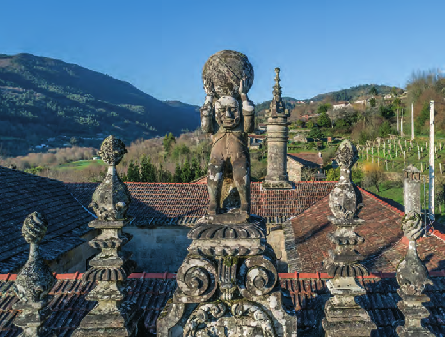 Atlas,flanked with pinacles and behind, the chimney.
Atlas,flanked with pinacles and behind, the chimney.The interior of the manor has a beautiful courtyard from which you can access the interior rooms through four different doors, one of them by means of a beautiful Galician skate. The kitchen, communicated with the body of the mill, preserves the most ample and monumental of the typical of the typical lares. It is an independent room, inside the kitchen, since it has side closing walls and a walls of lateral closing and entrance door; the bell, supported by thick columns of bases and capitals pseudodidactic and pseudo-Doric capitals..
The rooms and other outbuildings have been converted, at present, into huge halls (two) with numerous windows (two) with numerous large windows. Intramural staircases give access to the first floor, where the cellar is conserved with its the cellar with its fittings, the courts, blacksmith`s shop, etc. On the exterior there is also a stone granary with four clearings. It is very striking the great exterior end of the lar, cylindrical chimney, reinforced by a multitude of rings and rings and topped by pinnacles with pineapple, similar to those of the front. They are of highlighting also in this set and for the exterior the beautiful stairs of access to the church, with petril and very decorated handrails; the stairs of access to the belfry and the small stairway to the small access to the doorway of the manor,
with stone closings and benches on both sides, with two "monfortino" finials on both sides of the doors.
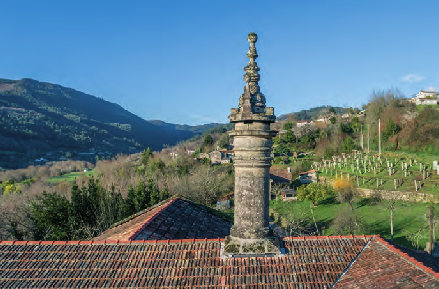 Detail of the manor`s chimney.
Detail of the manor`s chimney.
